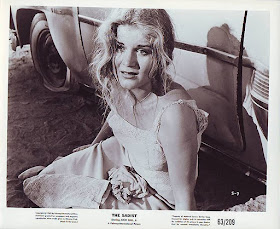Review by Steve D. Stones
Based on the 1959 novel – The Haunting of Hill House by Shirley Jackson, The Haunting (1963) ranks as one of the best haunted house-ghost story films in the genre. The film really packs a punch of scares and will make you want to sleep with a light on after you see it. It's a perfect film for the Halloween season.
Built in a remote area of New England by a man named Hugh Crane in the early 1870s, Hill House has a reputation for being evil and haunted because of a series of unfortunate accidents that took place there. Ninety years ago, the carriage of Crane's young wife crashes into a tree, killing her, before she even sets eyes on Hill House.
After the accident, Crane stays in the house and remarries while raising his daughter Abigail. Shortly after the marriage, his second wife falls down stairs in the house and is killed instantly. Crane is accused by locals of killing his second wife, so he flees to England, leaving Abigail in the house with a maid servant.
Abigail stays in the same nursery room of the house for her entire life until reaching old age as a bed ridden invalid.
One night while calling for the maid, Abigail dies in the nursery room. The maid inherits the house, but years later goes insane and hangs herself at the top of a spiral staircase in the library. The spiral staircase proves to be one of the creepiest features of the house, as we see in two separate incidences later in the film.
Being intrigued by all the stories and misery surrounding Hill House, Dr. John Markway, played by distinguished British actor Richard Johnson, decides to conduct a supernatural experiment in Hill House with carefully selected human subjects.
A distant relative in Boston of the maid rents the house to Markway, but warns him that everyone who ever stayed in the house never stayed there more than a few days.
Luke (Russ Tamblyn), whose aunt now owns Hill House, is one of the group of four staying in the house during Markway's experiment. He is a skeptic of Markway's investigations and beliefs in the supernatural.
Eleanor (Julie Harris) and Theodora (Claire Bloom) arrive at the house as test subjects. Eleanor has spent the last eleven years taking care of her ailing mother, so she is anxious to be a part of the group. Theodora was selected by Markway because of her skill of extra sensory perception. Eleanor was selected for experiencing a poltergeist as a child.
During the first night at Hill House, Eleanor and Theodora hear loud pounding sounds in the walls that get progressively louder. The pounding transitions into a loud laughter of a female voice. While passing Eleanor and Theodora's room that night, Luke and Markway claim they did not hear any pounding in the walls. The two women laugh off their experience as something unexplained.
At breakfast the next morning, Luke is asked if there is anything that frightens him. He mentions something in the hallway leading to the dining room that frightened him, so he takes the group to the hallway. On the hall wall written in chalk it says: Help Eleanor Come Home.
Already fragile, Eleanor has a complete breakdown after seeing her name written in chalk. Down the hall from the chalk writing, Dr. Markway discovers a “cold spot” in the hallway near the nursery where occupants standing in the spot can see their breath and feel cold chills.
Markway's wife Grace (Lois Maxwell) arrives at Hill House to warn her husband that a reporter has learned of his investigations at Hill House despite his attempts to keep the investigations a secret. Markway asks his wife to leave immediately, but she insists that she stay in the house with the group, even though she is a skeptic of the supernatural, much like Luke. She wants to stay in the nursery where Abigail spent most of her life.
Markway tells her the room is locked and he does not have a key, but the door is wide open as the group approaches the room.
Loud banging in the walls and high-pitched wind sounds penetrate the halls of the house the night Grace arrives. Markway runs from the parlor to go check on Grace in the nursery. Grace has disappeared and cannot be found.
While the group searches for Grace, Eleanor climbs the spiral staircase in the library and is frightened by Grace when she appears through a trap door at the top of the stairs.
On the DVD audio commentary for The Haunting, actress Julie Harris, who plays Eleanor, mentions that she felt very isolated and distant from the other actors during the production of the film. Her feelings reflect and enhance the great performance she gives on screen because she is the outcast of the group who is always emotionally fragile and distant from all the other actors on screen. On the DVD audio commentary, Actor Russ Tamblyn confirms that Harris was very distant from the other actors during the entire production.
Perhaps the biggest star of the film is the richly ornate, Rococo interiors of the house. The richly detailed relief wall carvings and sculptures in the house are a visual treat. A close up shot of a wall relief in Eleanor's room gives the chilling appearance of the face of a monster.
The stark black-and-white photography greatly enhances the scary and foreboding feeling of the film, which is one of many reasons why the 1999 color remake fails viewers. The 1963 film relies on the psychological impact of not showing any horror on the screen, but instead allowing the viewer to anticipate the horrors that might appear.
This Halloween season, I highly recommend the original 1963 chiller – The Haunting, directed by Robert Wise. Happy viewing and Happy Halloween!











